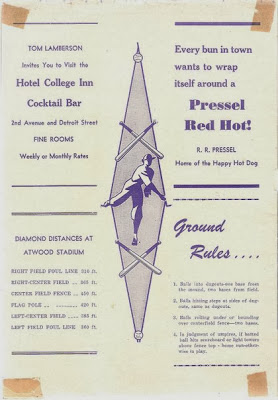Here are three programs I have from the legendary "Bless You Boys" season. I think I bought all three of them at either Gibraltar Trade Center or a flea market.
 |
| 1984 Season Yearbook |
After finishing in second place in 1983 (92-70), many were expecting the Tigers to take the next step and reach the postseason. Detroit signed free agent infielder Darrell Evans to add power and veteran leadership to the young lineup. But what really put the team over the top was a spring training trade with Philadelphia. The Tigers acquired infielder Dave Bergman and reliever Willie Hernandez from the Phillies. Hernandez was named the new closer for 1984, and was lights out all year.
Detroit jumped out to a 9-1, which included a no-hitter by Jack Morris. Before the rest of the AL East knew what hit them, the Tigers were a stunning 35-5, the best 40-game start in baseball history. Toronto kept it interesting for most of the summer, but the Tigers eventually pulled away, finishing the season at 104-58, a franchise best, and 15 games ahead of Toronto. The team never spent a day out of first place, the first "wire-to-wire" season since the vaunted 1927 Yankees.
 |
| 1984 ALCS--Tigers vs. Kansas City Royals |
The Tigers were heavily favored to take the series, and didn't disappoint. They crushed the Royals in the first two games, then returned home to finish them off in Game 3, 1-0. Tiger outfielder Kirk Gibson was named Series MVP.
It was the first American League pennant for Detroit since 1968. The Tigers then sat back and waited for the NLCS to conclude. San Diego would come back from a 2-0 deficit to clinch their first National League pennant, and would face the Tigers in the 1984 World Series.
 |
| 1984 World Series--Tigers vs. San Diego Padres |
Strangely, the Tigers would not have home-field advantage in this series. The first two games were scheduled for San Diego and, if necessary, so were Games Six and Seven. Didn't really matter. While San Diego won 92 games this year, most favored the Tigers to win.
The Padres' starting pitching was beyond atrocious in the Fall Classic. In four out of the five games, Padre starters did not survive past the third inning. The big names on offense mostly disappeared as well. As a unit, the team hit a so-so .263, but star players like Steve Garvey, Tony Gwynn, and Carmelo Martinez had a forgettable series.
After splitting the first two games in San Diego, the Series shifted to Detroit. The Tigers took control of the series with a 5-2 win, as wild Padres pitching allowed 11 walks. Alan Trammell provided all the offense needed for Game 4, with two two-run homers off starter Eric Show, as the Tigers won 4-2, for a 3-1 series lead.
In Game 5, the Tigers smacked around starter Mark Thurmond for three runs, chasing him off the mound in the first inning. San Diego didn't give up, and eventually tied the score at 3.
Detroit was ahead 5-4 in the eighth inning, with two runners on and Kirk Gibson at the plate. Conventional baseball wisdom says to walk Gibson (who was red hot at bat that day) and pitch to Lance Parrish. Reliever Goose Gossage declined, saying he had past success against Gibson and could strike him out. Gossage's first pitch was a ball, then Gibson drilled the second pitch into the upper deck in right field.
With the score 8-4 Tigers, the Series was pretty much over. Hernandez closed out the Padres in the ninth, and the Tigers celebrated the franchise's fourth World Series title. It was the first clinched in Detroit since 1935.
Aftermath: The Tigers were favored to repeat in 1985, but the magic was gone after one year. Detroit slumped to third place, behind Toronto and New York, with a disappointing 85-77. The Tigers would not return to the postseason until 1987, when a late season surge helped clinch the AL East title. They would be quickly pushed aside by the eventual World Champion Minnesota Twins in five games (best of seven). The Tigers franchise would go into steep decline after that season, and would not return to the playoffs until 2006.


















